25 CNC SYSTEMS – MECHANICAL COMPONENTS
The drive units of the carriages in NC machine tools are generally the screw & the nut mechanism. There are different types of screws and nuts used on NC machine tools which provide low wear, higher efficiency, low friction and better reliability.
25.1 Recirculating ball screw
The recirculating ball screw assembly shown in figure 25.1 has the flanged nut attached to the moving chamber and the screw to the fixed casting. Thus the moving member will move during rotational movement of the screw. These recirculating ball screw designs can have ball gages of internal or external return, but all of them are based upon the “Ogival” or “Gothic arc”.
In these types of screws, balls rotate between the screw and nut and convert the sliding friction (as in conventional nut & screw) to the rolling friction. As a consequence wear will be reduced and reliability of the system will be increased. The traditional ACME thread used in conventional machine tool has efficiency ranging from 20% to 30% whereas the efficiency of ball screws may reach up to 90%.
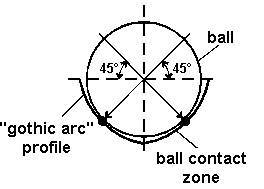
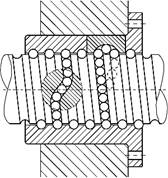
Figure 25.1: Recirculating ball screw assembly
Courtesy: www.physikinstrumente.com/7_9.html
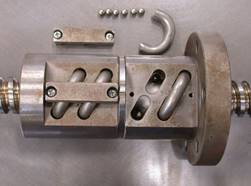
Figure 25.2: Preloaded recirculating ball screw
Courtesy: www. ommons.wikimedia.org/wiki/Image
There are two types of ball screws. In the first type, balls are returned through an external tube after few threads. In another type, the balls are returned to the start through a channel inside the nut after only one thread. To make the carriage movement bidirectional, backlash between the screw and nut should be minimum. One of the methods to achieve zero backlash is by fitting two nuts. The nuts are preloaded by an amount which exceeds the maximum operating load. These nuts are either forced apart or squeezed together, so that the balls in one of the nuts contact the opposite side of the threads.
These ball screws have the problem that minimum diameter of the ball (60 to 70% of the lead screw) must be used, limiting the rate of movement of the screw.
25.2 Roller screw
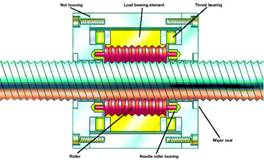
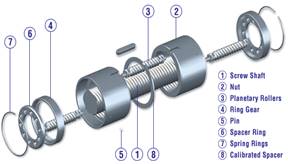
Figure 25.3: Roller screw
Courtesy:www.duffnorton.com/products/spiracon.aspx Courtesy:www.nookindustries.com/RollerScrew/RollerScrews
These types of screws provide backlash-free movement and their efficiency is same as that of ball screws. These are capable of providing more accurate position control. Cost of the roller screws are more compared to ball screws. The thread form is triangular with an included angle of 90 degrees. There are two types of roller screws: planetary and recirculating screws.
Planetary roller screws: Planetary roller screws are shown in figure 25.3. The rollers are threaded with a single start thread. Teeth are cut at the ends of the roller, which meshes with the internal tooth cut inside the nut. The rollers are equally spaced around and are retained in their positions by spigots or spacer rings. There is no axial movement of the rollers relative to the nut and they are capable of transmitting high load at fast speed.
Recirculating roller screws: The rollers in this case are not threaded and are provided with a circular groove and are positioned circumferentially by a cage. There is some axial movement of the rollers relative to the nut. Each roller moves by a distance equal to the pitch of the screw for each rotation of the screw or nut and moves into an axial recess cut inside the nut and disengage from the threads on the screw and the nut and the other roller provides the driving power. Rollers in the recess are moved back by an edge cam in the nut. Recirculating roller screws are slower in operation, but are capable of transmitting high loads with greater accuracy.
Source: http://nptel.ac.in/courses/Webcourse-contents/IIT-Delhi/Computer%20Aided%20Design%20&%20ManufacturingII/Module%20E/Module%20E(5)/e_5.doc
Web site to visit: http://nptel.ac.in/
Author of the text: indicated on the source document of the above text
If you are the author of the text above and you not agree to share your knowledge for teaching, research, scholarship (for fair use as indicated in the United States copyrigh low) please send us an e-mail and we will remove your text quickly. Fair use is a limitation and exception to the exclusive right granted by copyright law to the author of a creative work. In United States copyright law, fair use is a doctrine that permits limited use of copyrighted material without acquiring permission from the rights holders. Examples of fair use include commentary, search engines, criticism, news reporting, research, teaching, library archiving and scholarship. It provides for the legal, unlicensed citation or incorporation of copyrighted material in another author's work under a four-factor balancing test. (source: http://en.wikipedia.org/wiki/Fair_use)
The information of medicine and health contained in the site are of a general nature and purpose which is purely informative and for this reason may not replace in any case, the council of a doctor or a qualified entity legally to the profession.
The texts are the property of their respective authors and we thank them for giving us the opportunity to share for free to students, teachers and users of the Web their texts will used only for illustrative educational and scientific purposes only.
All the information in our site are given for nonprofit educational purposes